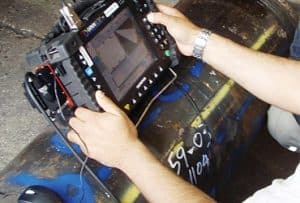Nondestructive Testing or Non-Destructive Testing (NDT) is a wide group of analysis techniques used in science and technology industry to evaluate the properties of a material, component or system without causing damage. The terms Nondestructive Examination (NDE), Nondestructive Inspection (NDI), and Nondestructive Evaluation (NDE) are also commonly used to describe this technology. Because NDT does not permanently alter the article being inspected, it is a highly valuable technique that can save both money and time in product evaluation, troubleshooting, and research. The six most frequently used NDT methods are eddy-current, magnetic-particle, liquid penetrant, radiographic, ultrasonic, and visual testing. NDT is commonly used in forensic engineering, mechanical engineering, petroleum engineering, electrical engineering, civil engineering, systems engineering, aeronautical engineering, medicine, and art. Innovations in the field of nondestructive testing have had a profound impact on medical imaging, including on echocardiography, medical ultrasonography, and digital radiography.
Various national and international trade associations exist to promote the industry, knowledge about non-destructive testing, and to develop standard methods and training. These include the American Society for Nondestructive Testing, the Non-Destructive Testing Management Association, the International Committee for Non-Destructive Testing, the European Federation for Non-Destructive Testing and the British Institute of Non-Destructive Testing.
NDT methods rely upon use of electromagnetic radiation, sound and other signal conversions to examine a wide variety of articles (metallic and non-metallic, food-product, artifacts and antiquities, infrastructure) for integrity, composition, or condition with no alteration of the article undergoing examination. Visual inspection (VT), the most commonly applied NDT method, is quite often enhanced by the use of magnification, borescopes, cameras, or other optical arrangements for direct or remote viewing. The internal structure of a sample can be examined for a volumetric inspection with penetrating radiation (RT), such as X-rays, neutrons or gamma radiation. Sound waves are utilized in the case of ultrasonic testing (UT), another volumetric NDT method – the mechanical signal (sound) being reflected by conditions in the test article and evaluated for amplitude and distance from the search unit (transducer). Another commonly used NDT method used on ferrous materials involves the application of fine iron particles (either suspended in liquid or dry powder – fluorescent or colored) that are applied to a part while it is magnetized, either continually or residually. The particles will be attracted to leakage fields of magnetism on or in the test object, and form indications (particle collection) on the objects surface, which are evaluated visually. Contrast and probability of detection for a visual examination by the unaided eye is often enhanced by using liquids to penetrate the test article surface, allowing for visualization of flaws or other surface conditions. This method (liquid penetrant testing) (PT) involves using dyes, fluorescent or colored (typically red), suspended in fluids and is used for non-magnetic materials, usually metals.
Analyzing and documenting a nondestructive failure mode can also be accomplished using a high-speed camera recording continuously (movie-loop) until the failure is detected. Detecting the failure can be accomplished using a sound detector or stress gauge which produces a signal to trigger the high-speed camera. These high-speed cameras have advanced recording modes to capture some non-destructive failures. After the failure the high-speed camera will stop recording. The capture images can be played back in slow motion showing precisely what happen before, during and after the nondestructive event, image by image.



